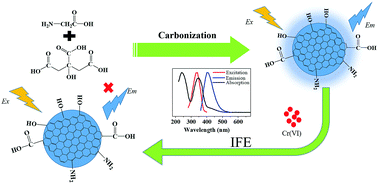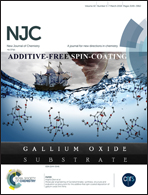Facile one-step synthesis of highly luminescent N-doped carbon dots as an efficient fluorescent probe for chromium(vi) detection based on the inner filter effect†
Abstract
Chromium is highly toxic and considered as a severe contaminate. Therefore, low cost, highly sensitive sensors for the determination of Cr(VI) are highly required. In the present study, highly luminescent N-doped carbon dots (CG-CDs) obtained from citric acid and glycine with a quantum yield of 78% and label-free fluorescent assay system were designed for Cr(VI) detection based on the inner filter effect (IFE). The CG-CDs were prepared by a one-step hydrothermal method using citric acid and glycine as carbon precursors. The fluorescent sensors showed rapid response, high selectivity, and sensitivity to Cr(VI). A good linear relationship between the concentration of Cr(VI) ions and fluorescence intensity was obtained in the range from 5 to 200 μmol L−1 (R2 = 0.98), and the limit of detection was calculated to be 4.16 μmol L−1 for Cr(VI). Importantly, this method has been successfully applied to the detection of Cr(VI) ions in simulated aquaculture water, which may be helpful to reduce the risk of Cr(VI) intake from contaminated water.



 Please wait while we load your content...
Please wait while we load your content...